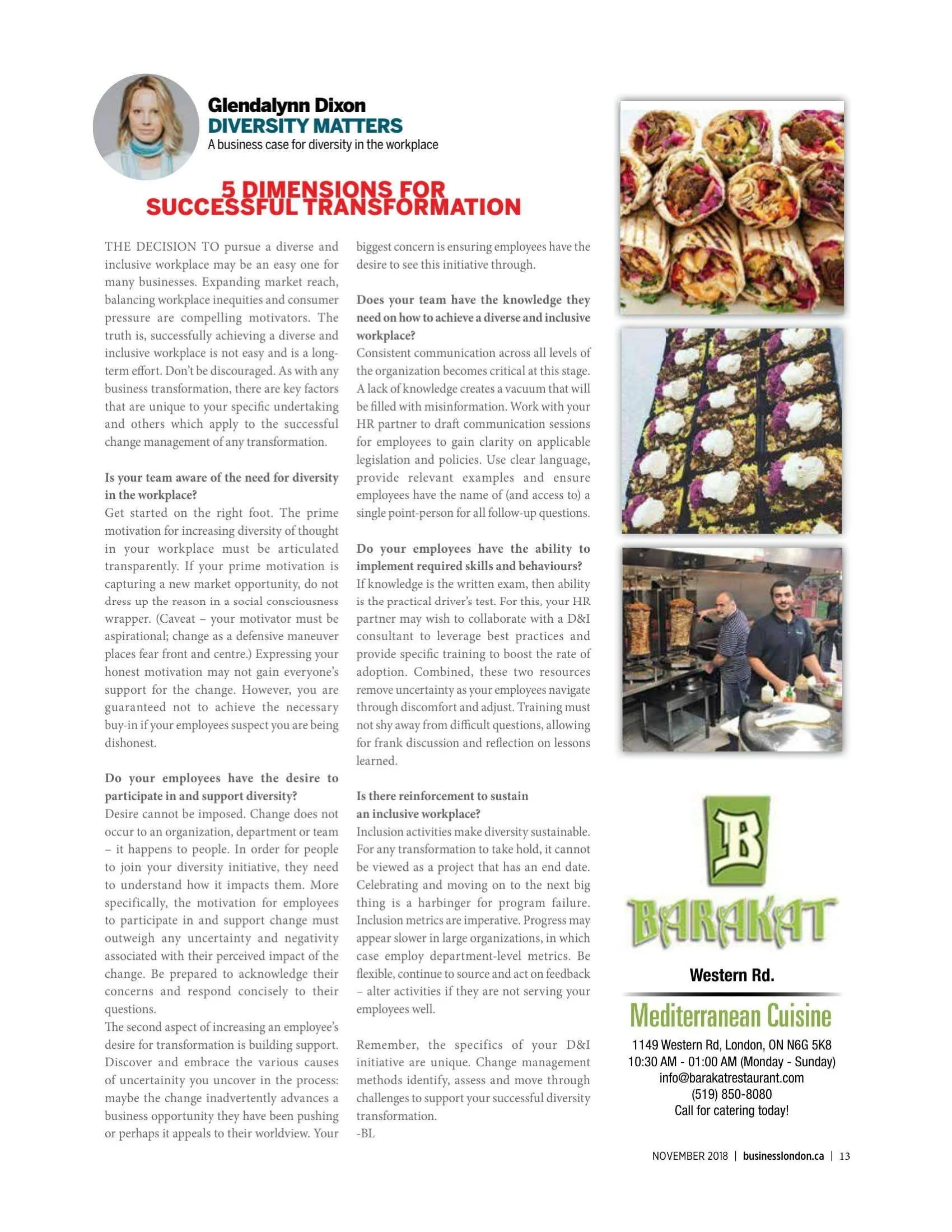5 Dimensions for Successful Transformation
The decision to pursue a diverse and inclusive workplace may be an easy one for many businesses.
Expanding market reach; balancing workplace inequities and consumer pressure are compelling motivators. The truth is, successfully achieving a diverse and inclusive workplace is not easy and is a long-term effort. Don’t be discouraged. As with any business transformation, there are key factors that are unique to your specific undertaking (Diversity & Inclusion) and others which apply to the successful change management of any transformation.
Let’s approach the creation of a D&I program in your workplace from the change management perspective. The following 5 dimensions of successful transformation will assist you in identifying hurdles before they appear and aid you in seeking the right support. As with all positive transformation initiatives, communication is imperative.
Is your team aware of the need for diversity in the workplace?
Get started on the right foot. The prime motivation for increasing diversity of thought in your workplace must be articulated transparently. If your prime motivation is capturing a new market opportunity, do not dress up the reason in a social consciousness wrapper. (caveat – your motivator must be aspirational; change as a defensive maneuver places fear front and centre) Recognize, you may not gain everyone’s support for the change by expressing your honest motivation. However, you are guaranteed not to achieve the buy-in necessary if your employees suspect you are being dishonest.
For example, acknowledge that your organization will make significant strides in closing gender inequities while pursuing a financially appealing opportunity. You have tied the positive socially conscious outcome to a positive business outcome from the outset.
Does your team have the desire to participate and support diversity?
Original article, Business London Magazine, November 2018
Desire cannot be imposed. Change does not occur to an organization, department or team - it happens to people. In order for people to join in your diversity initiative they need to understand how it impacts them. More specifically, the motivation for employees to participate in, and support change must outweigh any uncertainty and negativity associated with their perceived impact of the change. How will the team dynamics shift? How will their day-to-day responsibilities change? What if the change fails, what happens next? Be prepared to acknowledge their concerns and respond concisely to their questions.
The second aspect of increasing an employee’s desire for transformation is building support. Their motivation for supporting your enterprise may be as personalized as their concern about how it might impact them. Ideally, everyone would embrace the prime motivator you listed in the first step, but you must prepare for the reality that your motivation is not shared. Discover and embrace the various reasons you uncover in the process: maybe the change inadvertently advances a business opportunity they have been pushing or perhaps it appeals to their worldview. Your biggest concern is ensuring employees have the desire to see this initiative through. A lack of desire manifests into resistance.
Does your team have the knowledge they need on how to achieve a diverse and inclusive workplace?
Support the momentum gained from the first two steps by providing employees with the knowledge required to achieve a diverse workplace. Consistent communication across all levels of the organization becomes critical at this stage. A lack of knowledge creates a vacuum that will be filled with misinformation. Work with your HR partner to draft communication sessions for employees to gain clarity on applicable legislation and policies. Use clear language, provide relevant examples and ensure employees have the name of (and access to) a single point-person for all follow-up questions.
Do your employees have the ability to implement the required skills and behaviours?
If knowledge is the written exam, then the ability is the practical driver’s test. For this, your HR partner may wish to collaborate with a D&I consultant to leverage best practices and provide specific training to boost the rate of adoption. Combined, these two resources remove uncertainty as your employees navigate through discomfort and adjust. This training must not shy away from difficult questions, allowing for frank discussion and reflection on lessons learned.
Is there reinforcement to sustain an inclusive workplace?
Inclusion activities make diversity sustainable. For any transformation to take hold, it cannot be viewed as a project that has an end date. Celebrating and moving on to the next big thing is a harbinger of program failure. Inclusion metrics are imperative. Progress may appear slower in large organizations, in which case employ department-level metrics. Be flexible, continue to source and act on feedback – alter activities if they are not serving your employees well.
Remember, the specifics of your D&I initiative are unique. Change management methods identify, assess and move through challenges to support your successful diversity transformation.


